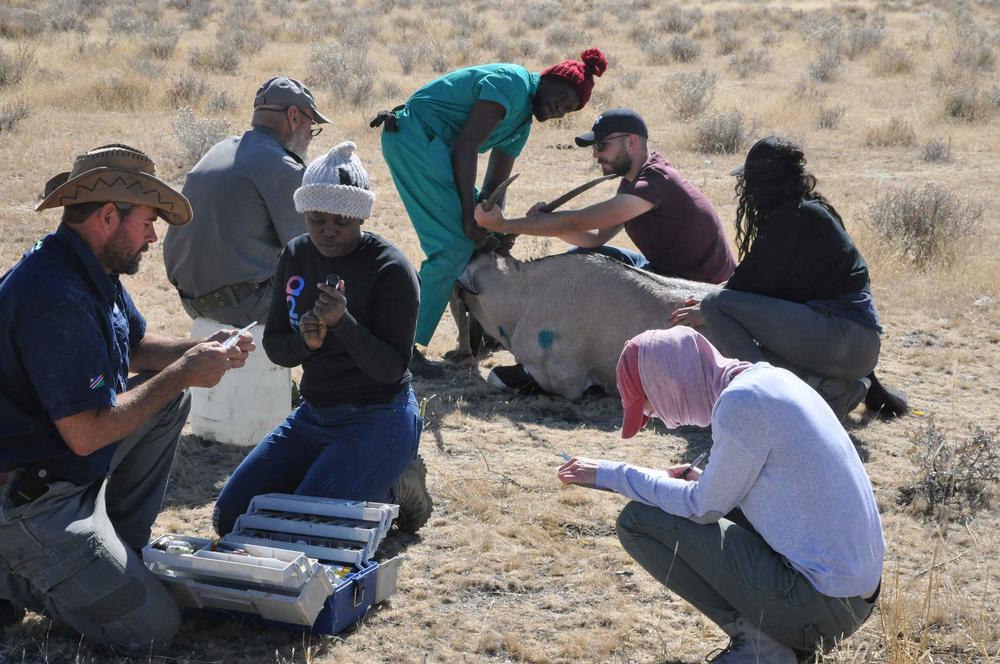Where the Wild Things Are
A student exchange to Namibia has given Freie Universität students insights into the field of wildlife veterinary medicine
Jan 09, 2023
Just another day at the office. Together with local students, veterinary medicine student Thomas Conrad (back row, second from right) examines an oryx antelope.
Image Credit: Carola Fischer-Tenhagen
Lions, and zebras, and wildebeest... oh my! When veterinary medicine student Thomas Conrad describes the animals he dealt with during his trip to Namibia, it becomes clear that he has had an experience that many of his peers can only dream of. “It is very difficult to gain veterinary experience with wild animals in Germany,” he explains. “Zoos are the only places that can offer this kind of experience, but internship places are few and far between – and extremely popular.” The opportunity offered by the Department of Veterinary Medicine at Freie Universität to take part in a week-long trip to Namibia was no exception. More than forty applications were received for the elective course within twenty-four hours. The twelve lucky students selected to take part in the course were then notified – among them Thomas Conrad, who is in his ninth semester of studying veterinary medicine.
Erasmus+ Program Promotes Exchange Between Germany and Namibia
The trip was made possible thanks to a collaboration with the University of Namibia (UNAM), which in turn came about through the Erasmus+ exchange program. Carola Fischer-Tenhagen has been advocating this partnership for ten years – since UNAM opened its School of Veterinary Medicine in 2012. “If you’re wanting to gain experience in wildlife veterinary medicine, you’d be hard pressed to find somewhere better than Namibia,” says Dr. Fischer-Tenhagen, who works at the Department of Veterinary Medicine at Freie Universität and has recently accepted a position at the German Federal Institute for Risk Assessment. And she would know. After all, Namibia is where Dr. Fischer-Tenhagen once carried out field work for her doctoral thesis on the topic of infectious diseases among rhinoceroses.
In the beginning, the cooperation between Freie Universität and UNAM took the form of an exchange between instructors, researchers, and administrative staff. Students were able to take part in the program for the first time during the 2022 summer semester. The twelve students selected for the exchange were divided into three teams of four. Following a preparatory seminar within the department, these teams then traveled with Dr. Fischer-Tenhagen to Etosha National Park, a national park located in the north of Namibia approximately 22,000 km2 in size. Each team carried out their work on site for a different week in June, and were joined by three Namibian students and two veterinarians. “Ensuring that wild animals stay healthy and breed successfully is very important for the Namibian economy,” notes Dr. Fischer-Tenhagen. For this reason, gaining practical experience with wildlife in the national parks is a standard part of any veterinary medicine student’s curriculum in Namibia.
Tranquilizer Guns 101
While the Namibian students learned how to correctly use tranquilizer guns on wild animals, the Freie Universität students monitored the sedation of the animals and took blood or hair samples from springboks, wildebeest, and oryx antelopes. They also fitted lions, leopards, and hyenas with GPS collars to collect data on their movements.
At the same time, Thomas Conrad emphasizes that no animal was ever tranquilized unnecessarily. “The animals are only ever sedated in order to collect data for ongoing research projects.” Sometimes the students also had to sedate the animals to help save them. “Some zebras had been targeted by poachers and were running around with snares around their necks. We were only able to remove the snares after sedating the animals.”
The Poaching Problem
“I had no idea that poaching is such a huge problem in the national parks here,” says Conrad. Poachers killed eleven black rhinoceroses for their horns in June alone. “This was something that was very difficult to learn; becoming aware of this sad truth has really changed me.” On the other hand, when listing the positive aspects of the trip, Conrad considers the time spent with the UNAM students back at camp a particular highlight. He was especially impressed by the stories of two female Namibian students who moved from their village to the city to study – the first members of their families to do so. “They emancipated themselves, despite not always being supported in their decision to study,” says Conrad. “It was fascinating to learn how both women were nevertheless able to integrate their culture and tradition into their new lives as students in the city.”
Dr. Fischer-Tenhagen is particularly passionate about stories like these. “We are not only interested in exchanging veterinary knowledge – promoting cultural exchange among the students is also a very important part of the program,” she says. Her group included students from three different cultural groups within Namibia: a Herero student, a Himba student, and a Damara student. They all grew up in a very traditional culture, with some only able to set foot in a school for the first time from the age of twelve – after completing an hour-long walk to get there. “Access to education is not a given here,” says Dr. Fischer-Tenhagen. “Our students have been significantly affected by this trip; it has clearly changed them. They have gained a new perspective on life.”
The experience has also left its mark on Thomas Conrad. He is thinking of getting involved with the organization “Veterinarians Without Borders” after completing his studies. Maybe this will allow him to return to Namibia one day.
This article originally appeared in German on November 25, 2022, in the Tagesspiegel newspaper supplement published by Freie Universität Berlin.

